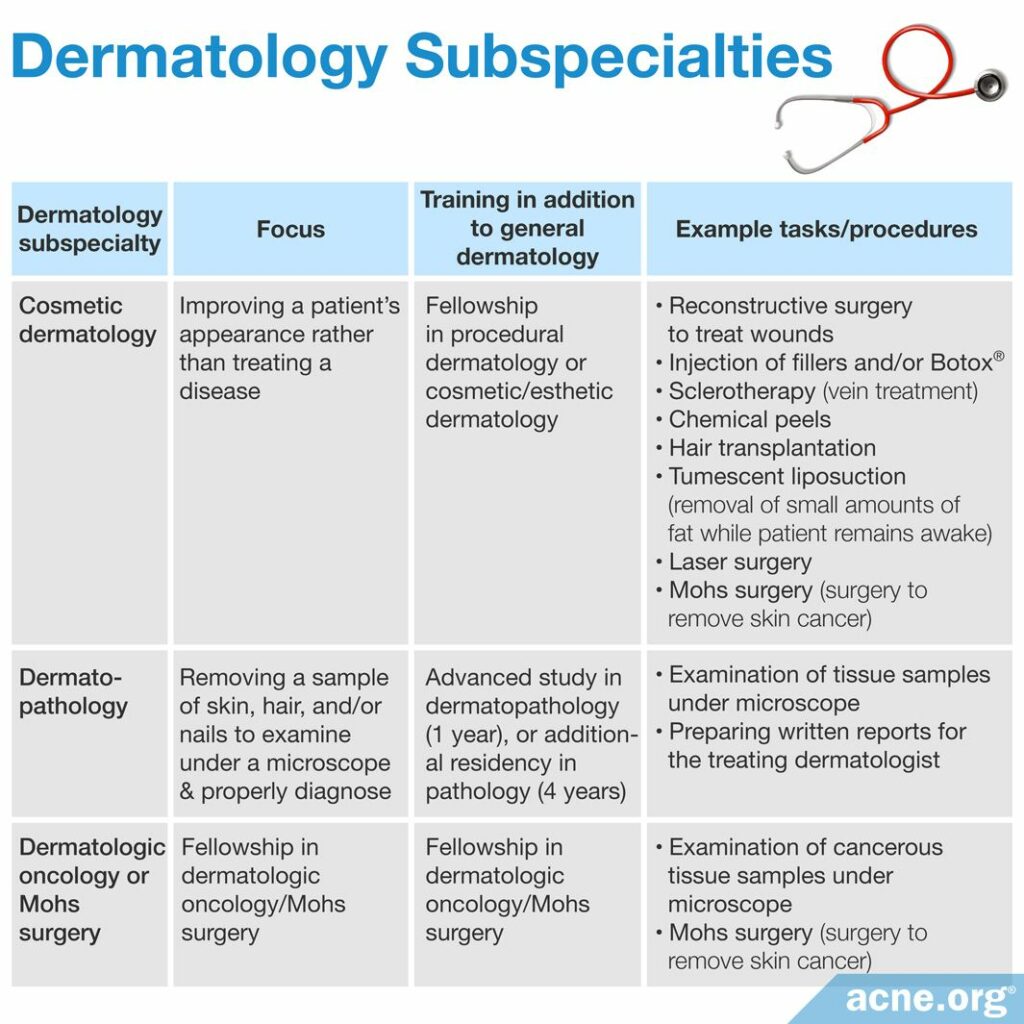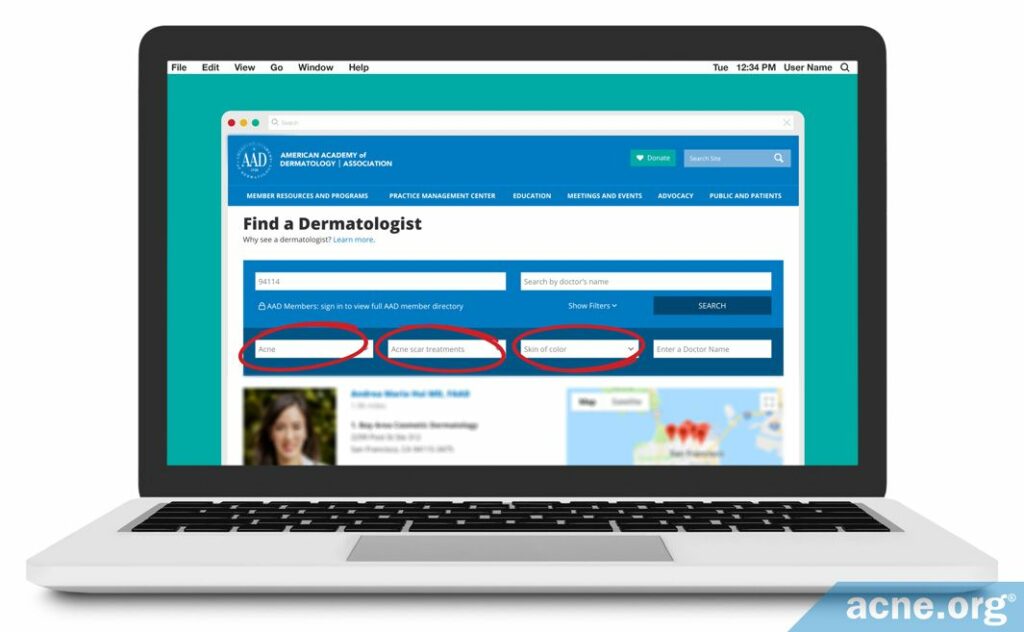Search the American Academy of Dermatology Website for a Board-certified Dermatologist with an Interest in Acne, Look Around for Reviews, and Trust Your Gut

The Essential Info
The right dermatologist can make a big difference to your patient experience and the success of your acne treatment plan. Here are the steps to find a dermatologist who is a good fit:
- Use the search feature on the American Academy of Dermatology website to look for board-certified dermatologists in your area, and filter the search results for doctors with a special interest in treating acne.
- Read online patient reviews of any dermatologists you are considering and ask people you know whether they have any experience with these dermatologists.
- Do your research on acne and go to your first appointment with questions prepared.
- Listen to what your gut feeling tells you about your potential to be comfortable and develop a good doctor-patient relationship with this dermatologist.

The Science
- What is A Dermatologist?
- When to See A Dermatologist
- Types of Dermatologists
- Choosing the Right Dermatologist for You
- The Bottom Line
What is A Dermatologist?
A dermatologist is a medical doctor who specializes in treating disorders of the skin, hair, and nails.1,2 Therefore, a dermatologist is the most appropriate type of doctor to consult about acne.
When to See A Dermatologist
For most cases of acne, an effective topical acne treatment using over-the-counter products can provide for completely clear skin without concerning side effects. Therefore, most people who experience acne do not end up seeing a physician about the problem. However, sometimes seeing a dermatologist about acne is prudent, particularly in the following cases:
Females: If you are experiencing irregular menstruation and/or increased hair growth, learn more about poly-cystic ovary syndrome (PCOS). If you suspect you may have PCOS, or if you suspect that you may be producing too many androgens (male hormones present in both males and females), a dermatologist can prescribe oral contraceptives (birth control pills) that are proven to effectively reduce androgen levels and treat acne at the same time. Warning: While effective in reducing acne, oral contraceptives come with potentially concerning side effects and drawbacks. For this reason, if after conducting a blood test, no hormonal imbalance is found, many females with acne choose to forgo hormonal treatment, opting instead for safer options.
Additionally, if you are a female who is experiencing severe and scarring acne, the oral prescription, isotretinoin, is a weapon in your and your dermatologist’s arsenal. However, like many weapons, it can have major unintended consequences. For instance, isotretinoin causes severe birth defects and spontaneous abortion. In fact, it is the #1 most birth-defect causing medication on the market. And when it comes to the woman herself, isotretinoin can permanently change the skin and the body, sometimes in unwanted ways. For these reasons, isotretinoin is approved only as a last-resort option for severe acne, and must be entered into extremely cautiously.
Males: Hormonal treatment is not an option for males, so when it comes to boys and men with acne, a dermatologist may be in order when acne is severe and/or scarring, and particularly when acne is widespread over large parts of the body. In cases like these, isotretinoin is an oral prescription medication that you and your dermatologist may choose to consider as an option. Isotretinoin is effective in reducing acne, and providing lasting reduction or relief in symptoms. However, the power of isotretinoin comes with a shadow side of powerful side effects, and can leave the user’s skin and body permanently altered, sometimes in unwanted ways. For this reason, it is approved only for severe acne, and must be entered into extremely cautiously. However, in some cases of severe, scarring acne, early intervention can help prevent a lifetime of scarring.
Types of Dermatologists
Becoming a dermatologist is a long journey, consisting of 4-5 stages in the United States:
- Attending college/university to earn a Bachelor’s degree
- Attending medical school to become a Medical Doctor (MD) or Doctor of Osteopathic Medicine (DO)
- Completing an internship lasting 1 year
- Completing a residency program in Dermatology lasting 3 years or more
- [Optional] Completing a fellowship program to receive advanced training in a particular type of dermatology
Steps 1 – 3 are the same for any aspiring doctor. In other words, a future dermatologist undergoes the same general medical training as a family doctor or cardiologist.
However, in Step 4, the paths of different doctors diverge. The would-be dermatologist goes on to receive additional training in treating conditions of the skin, hair, and nails, while a cardiologist focuses on treating the heart and blood vessels.1,2
And that’s not all. Even different dermatologists can choose different paths in Steps 4 and 5 depending on what type of dermatology they want to practice.
Different types of dermatologists

Dermatologists fall into two broad categories, and when it comes to acne, a general dermatologist is normally the way to go:
- General dermatologists: These dermatologists choose no subspecialty (particular type of dermatology) and rely only on the skills they gain during their general dermatology training. This training covers all areas of dermatology, but not in as much depth as the training of someone who specializes might cover. General dermatologists complete only a general dermatology residency in Step 4 and no fellowship (Step 5). A general dermatologist is almost always the type you need to see for acne treatment. Acne is a common skin condition, and there is no specific type of dermatology that focuses on acne.
- Subspecialist dermatologists: These dermatologists specialize in particular types of dermatology, such as Cosmetic Dermatology or Pediatric Dermatology. This typically involves completing an additional residency in Step 4 and/or a fellowship program to gain advanced training (Step 5).1,2
In some special cases, you might want to see a subspecialist dermatologist for acne. For example, someone looking to treat scars or hyperpigmentation resulting from acne may want to consult a cosmetic dermatologist. On the other hand, a child suffering from infantile (childhood) acne may need to see a pediatric dermatologist.3
Now that you know what type of dermatologist to look for, let’s talk about how to find the right one.
Choosing the Right Dermatologist for You
First and foremost, make sure that any dermatologist you are considering is a medical doctor who is board-certified in dermatology. This ensures that she has completed medical training in dermatology and passed the required examinations. Keep in mind that some professionals licensed to perform certain skin treatments, like chemical peels and laser treatments, are not doctors, but rather estheticians or cosmetologists. These practitioners lack the necessary training to diagnose skin conditions or to prescribe treatments. This is why it is important to select a board-certified dermatologist.
Step 1: Find a board-certified dermatologist

To find a board-certified dermatologist in the United States, you can use the search feature on the American Academy of Dermatology (AAD) website. Enter your zip code or City/State to narrow down the search to your area.
Step 2: Find a dermatologist with experience in acne
While there is no formal specialization in acne, a general dermatologist who takes a special interest in treating acne can attend conferences and workshops on acne and keep up-to-date on the latest research.3 Such a doctor will tend to attract patients with acne and will end up gaining more experience with the condition as well.
To find U.S. dermatologists with a particular interest in acne, filter your search results on the AAD website by choosing “Acne” in the “Any condition” box. This will turn up fewer doctors than if you had left the box blank, but these doctors should be a better fit for you.
You can then filter the results further if you need a particular type of procedure. For example, to find someone who specializes in acne scars, select “Acne scars treatment” in the “Any Procedure” field.
Finally, you can narrow down your search by the focus of the dermatologist’s focus. For example, to find a dermatologist who specializes in treating people with skin of color, select “Skin of color” in the “Any Practice Focus” field.

Once you have found a few doctors focusing on acne in your area, try to gather some intel on them to gauge whether they might be a good fit for you.
Step 3: Gauging whether a dermatologist will be a good fit for you
To get an idea of whether a particular dermatologist may be right for you, try the following:
- Read patient reviews of the dermatologist on websites like Yelp or Zocdoc
- Talk to your family doctor or general practitioner about his or her opinion of this dermatologist
- Ask other people you know suffering from acne whether they have any experience with this dermatologist
Keep in mind that each person’s opinion is subjective, so your own experience may be different. Often, the only way to really know whether a dermatologist will be a good fit for you is to make an appointment for a consultation and base your decision on how that appointment goes. To maximize your chances of making an informed decision, it’s best to go to your first appointment prepared.
Step 4: Preparing for your first appointment
It may be difficult to tell just how competent a dermatologist is unless you know quite a bit about acne yourself. Use the time before your first appointment to educate yourself on acne and popular acne treatments on our website.
Go prepared with questions that you would like to ask your dermatologist. It is best to write them down so that you do not forget anything and can make the most of your time at the appointment. For example, you might want to ask your doctor:
- What type of acne do I have?
- What can I do in the short term to improve my acne?
- What kind of treatment is best to start with, and what are its side effects?
- How long will it take to see results?
- Besides acne, I have oily skin, which bothers me. Will acne treatment help with that as well?
- What kind of makeup can I use that will not make my acne worse?
In addition, you should be prepared to answer questions that the dermatologist may ask you, such as:
- What kind of medications do you use?
- What is your current skincare routine?
- What are the products you currently use on your face? (If you can, take the products with you to the appointment.)
- How long have you had acne?
- What treatments have you tried so far?
- What health issues, past and present, have you and your family had?
Step 5: Evaluating your first appointment
At the end of your first appointment, ask yourself whether you feel comfortable with the doctor and trust him to competently treat your acne.
Some possible red flags indicating that you might want to look for another doctor are:
- You felt rushed during the appointment
- The doctor showed little interest in listening to your symptoms and concerns
- The doctor failed to examine you closely and just took your word for your symptoms
- The doctor failed to explain the available treatment options
- The doctor prescribed treatments without explaining side effects
The Bottom Line
When it comes to finding a doctor to treat your acne, the most important thing to look for is a medical doctor who is board-certified in dermatology. Search for a doctor who takes a special interest in acne and try to gather information on her before making an appointment. When you meet with the doctor, ask questions and pay attention to your gut feeling to decide whether the doctor will be a good fit.
References
- American Academy of Dermatology. Subspecialties of dermatology. (2019). Available at: https://www.aad.org/what-is-a-derm
- Hoey, S. So you want to be a dermatologist. Ulster Med J 81, 172 (2012). https://www.ncbi.nlm.nih.gov/pubmed/23620620
- American Academy of Dermatology. Basic Dermatology Curriculum. (2019). https://www.aad.org/member/education/residents/medical-students
 Acne.org Products
Acne.org Products